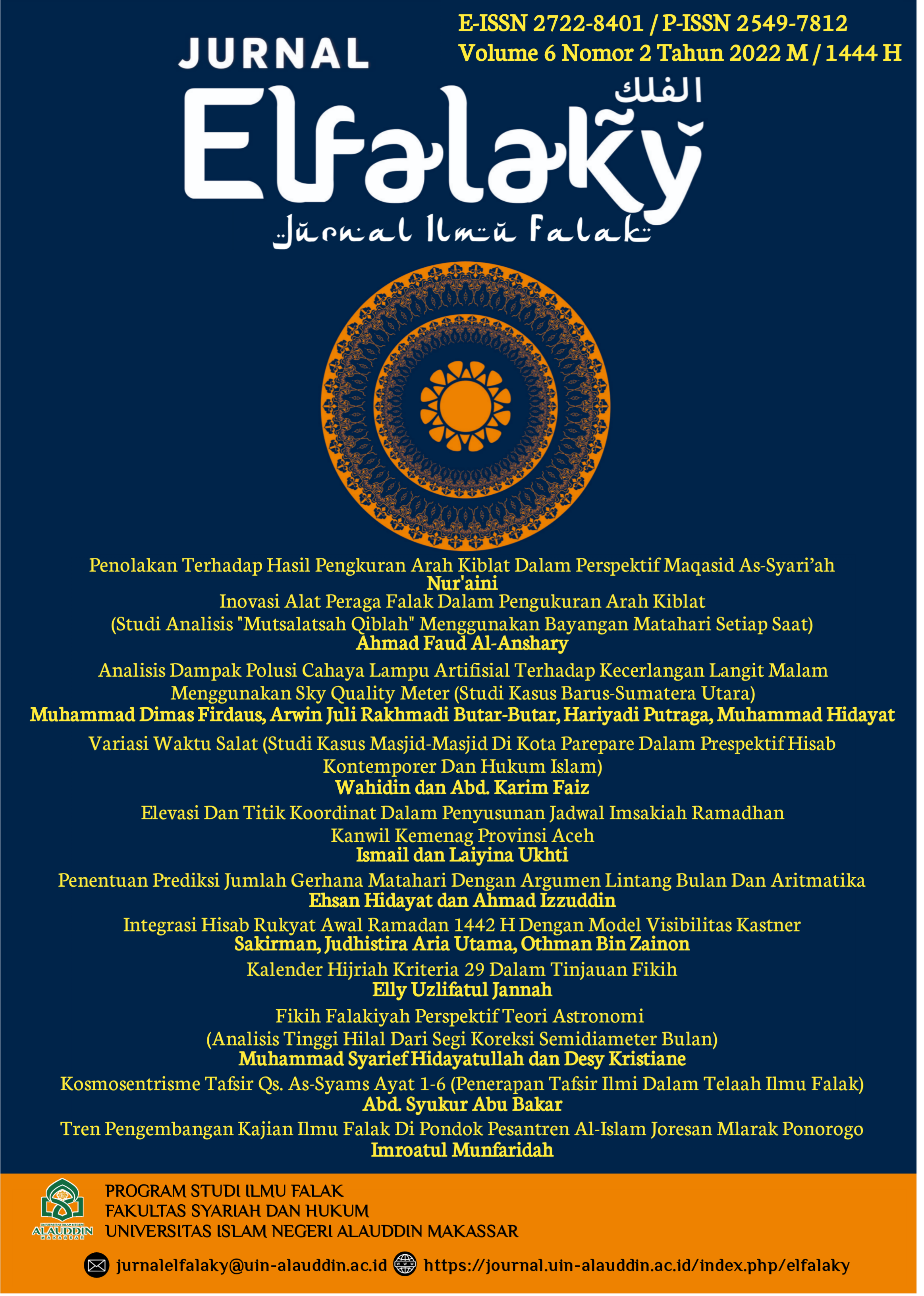INOVASI ALAT PERAGA FALAK DALAM PENGUKURAN ARAH KIBLAT (Studi Analisis "Mutsalatsah Qiblah" Menggunakan Bayangan Matahari Setiap Saat)
Abstract
Qibla direction is the closest direction to the Kaaba. Measuring the Qibla direction is important in society. The problem of Qibla direction is not only a matter of worship, but also related to social problems and community habits. Allah has created the sun as the source of human life. In connection with determining the direction of Qibla, the sun becomes an accurate Qibla direction. Humans wherever they are, as long as they can see sunlight, they can actually determine the direction of Qibla.
There are several ways to determine the Qibla direction, ranging from simple to complex. With a simple and low-cost method, it is hoped that it can be an alternative in determining the exact direction of Qibla. With the innovation of the Mutsalatsah Qiblah tool, it is hoped that it will be able to answer the challenges of life that are growing day by day. For this reason, Mutsalatsah Qiblah answers this need, with a simple tool and embedded several other supporting components, which are expected to have the same accuracy as manufactured products such as digital theodolites which have high accuracy.
References
Azhari, Susiknan. 2001. Ilmu Falak Teori dan Praktik (Cet.I). Jogyakarta: Lazuardi.
_____. 2004. Ilmu Falak Perjumpaan Khazanah Islam dan Sains Modern, Yogyakarta: Suara Muhammadiyah.
_____. 2005. Ensiklopedi Hisab Rukyah (Cet. I), Jogyakarta: Pustaka Pelajar.
_____. 2002. Pembaharuan Pemikiran Hisab di Indonesia.Yogyakarta: Pustaka Pelajar.
Dawanas, D.N. 1996. Dasar-dasar Astronomi Bola. Bandung: ITB Press.
Hambali, Slamet. 1998. Ilmu Falak I (Tentang Penentuan Awal Waktu Salat dan Penentuan Arah Kiblat di Seluruh Dunia), Semarang
_____. 2013. Arah Kiblat Setiap Saat, Yogyakarta: Pustaka Ilmu
Izzuddin, Ahmad. 2012. Ilmu Falak Praktis. Semarang: Pustaka Rizki Putra
Khazin, Muhyiddin. 2004. Ilmu Falak dalam Teori dan Praktik, (Perhitungan, Arah Kiblat, Waktu Sholat, Awal Bulan, dan Gerhana). Yogyakarta: Buana Pustaka
_____. 2005. Kamus Ilmu Falak (Cet. I). Yogjakarta: Pustaka Pelajar.
_____. 2006. Cara Mudah Mengukur Arah Kiblat (Cet. II). Yogyakarta: Buana Pustaka.
Moleong, Lexy J. 2007. Metodologi Penelitian Kualitatif. Bandung : PT. Remaja Rosdakarya
Sugiyono. 2005. Memahami Penelitian Kualitatif. Bandung : Alfabeta
Sugiyono. 2019. Metode Penelitian Kuantitatif Kualitatif dan R&D. Bandung : Alfabeta
Syarif, Muh. Rasywan. Ilmu Falak Integrasi Agama dan Sains. Cet.I; Gowa: Alauddin University Press, 2020.
Syarif, Muh. Rasywan. “Problematika Arah Kiblat dan Aplikasi Perhitungannya”, Hunafa 9, no.2 (2012), h. 245-269
Winarni, Endang Widi. Teori dan Praktik Penellitian Kuantitatif Kualitatif (Penelitian Tindakan Kelas (PTK) Research and Development (R&D)). Jakarta : Bumi Aksara





